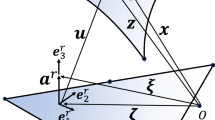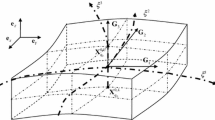Abstract
This work addresses simultaneous use of geometrically exact shear-rigid rod and shell finite elements and describes both models within the same framework. Parameterization of the rotation field is performed by Rodrigues rotation vector, which makes the incremental updating of the rotational variables remarkably simple. For the rod element, cubic Hermitian interpolation for the displacements together with quadratic Lagrange interpolation for the incremental torsion angle were employed, while, for the triangular shell element, a complete quadratic Lagrange interpolation was used. The internal incremental torsion angle resulting from the displacement field within the shell element is then made compatible with the boundary incremental torsion angle of the shell element by an internal Lagrange multiplier. The compatibility between contiguous shell elements as well rod elements is mastered in the standard way by simply connecting nodes. This technique is an important contribution of the work, whose performance is illustrated by several numerical examples.




















Similar content being viewed by others
References
Costa e Silva C, Maassen SF, Pimenta PM, Schröder J (2020) A simple finite element for the geometrically exact analysis of Bernoulli-Euler rods. Comput Mech 65:905–923. https://doi.org/10.1007/s00466-019-01800-5
Viebahn N, Pimenta PM, Schroeder J (2016) A simple triangular finite element for nonlinear thin shells: statics, dynamics and anisotropy. Comput Mech 59(2):281–297. https://doi.org/10.1007/s00466-016-1343-6
Pimenta PM, Campello EMB (2009) Shell curvature as an initial deformation: a geometrically exact finite element approach. Int J Numer Methods Eng 78(9):1094–1112. https://doi.org/10.1002/nme.2528
Campello EMB, Pimenta PM, Wriggers P (2003) A triangular finite shell element based on a fully nonlinear shell formulation. Comput Mech 31(6):505–518. https://doi.org/10.1007/s00466-003-0458-8
Pimenta PM, Almeida Neto ES, Campello EMB (2010) A fully nonlinear thin shell model of Kirchhoff-Love type. In: De Mattos Pimenta P, Wriggers P (eds) New trends in thin structures: formulation, optimization and coupled problems, vol 519. CISM International Centre for Mechanical Sciences, Springer, Vienna. https://doi.org/10.1007/978-3-7091-0231-2_2
Simo JC, Fox DD, Rifai MS (1990) On a stress resultant geometrically exact shell model. Part III: computational aspects of the nonlinear theory. Comput Methods Appl Mech Eng 79(1):21–70. https://doi.org/10.1016/0045-7825(90)90094-3
Basar Y, Ding Y (1992) Finite rotation shell elements for the analysis of finite rotation shell problems. Int J Numer Methods Eng 34:165–169
Eberlein R, Wriggers P (1999) Finite element concepts for finite elastoplastic strains and isotropic stress response in shells: theoretical and computational analysis. Comput Methods Appl Mech Eng 17:243–278
Gruttmann F, Wagner W, Meyer L, Wriggers P (1993) A nonlinear composite shell element with continuous interlaminar shear stresses. Comput Mech 13:175–188
Hughes TJR, Liu WK (1981) Nonlinear finite element analysis of shells: part I. Three-dimensional shells. Comput Methods Appl Mech Eng 26(3):1331–1362. https://doi.org/10.1016/0045-7825(81)90121-3
Pimenta PM, Campello EMB, Wriggers P (2004) A fully nonlinear multi-parameter shell model with thickness variation and a triangular shell finite element. Comput Mech 34(3):181–193. https://doi.org/10.1007/s00466-004-0564-2
Kiendl J, Hsu MC, Wu MCH, Reali A (2015) Isogeometric Kirchhoff-Love shell formulations for general hyperelastic materials. Comput Methods Appl Mech Eng 291:280–303. https://doi.org/10.1016/j.cma.2015.03.010
Greco L, Cuomo M, Contrafatto L (2019) Two new triangular G1-conforming finite elements with cubic edge rotation for the analysis of Kirchhoff plates. Comput Methods Appl Mech Eng 356:354–386. https://doi.org/10.1016/j.cma.2019.07.026
Argyris JH (1982) An excursion into large rotations. Comput Methods Appl Mech Eng 32(1–3):85–155
Simo JC, Fox DD, Hughes TJR (1992) Formulations of finite elasticity with independent rotations. Comput Methods Appl Mech Eng 95:277–288
Reissner E (1972) On one-dimensional finite-strain beam theory: the plane problem. J Appl Math Phys 23(5):795–804
Antman SS (1974) Kirchhoff’s problem for nonlinearly elastic rods. Q Appl Math 32:221–240
Simo JC (1985) A finite strain beam formulation. The three-dimensional dynamics. Part I. Comput Methods Appl Mech Eng 49(1):55–70
Gruttmann F, Sauer R, Wagner W (1997) A geometrical nonlinear eccentric 3D-beam element with arbitrary cross-sections. Comput Methods Appl Mech Eng 160(3–4):383–400
Gruttmann F, Sauer R, Wagner W (2000) Theory and numerics of three-dimensional beams with elastoplastic material behaviour. Int J Numer Methods Eng 48(12):1675–1702
Gruttmann F, Sauer R, Wagner W (1999) Shear stresses in prismatic beams with arbitrary cross-sections. Int J Numer Methods Eng 45(7):865–889
Pimenta PM, Yojo T (1993) Geometrically-exact analysis of spatial frames. Appl Mech Rev ASME 46(11):118–128
Pimenta PM (1996) Geometrically-exact analysis of initially curved rods. In: Topping BHV (ed) Advances in computational techniques for structural engineering, vol 99-108. Civil-Comp Press, Edinburgh
Pimenta PM, Campello EMB (2003) A fully nonlinear multi-parameter rod model incorporating general cross-section in-plane changes and out-of-plane warping. Latin-Am J Solids Struct 1(1):119–140
Simo JC, Vu-Quoc L (1986) A three-dimensional finite-strain rod model. Part II: computational aspects. Comput Methods Appl Mech Eng 58(1):79–116
Simo JC, Vu-Quoc L (1991) A geometrically-exact rod model incorporating shear and torsion-warping deformation. Int J Solids Struct 27(3):371–393
Simo JC (1992) The (symmetric) Hessian for geometrically nonlinear models in solid mechanics: intrinsic definition and geometric interpretation. Comput Methods Appl Mech Eng 96:189–200
Sokolov I, Krylov S, Harari I (2015) Extension of non-linear beam models with deformable cross sections. Comput Mech 56:999–1021
Armero F, Valverde J (2012) Invariant Hermitian finite elements for thin Kirchhoff rods. I: the linear plane case. Comput Methods Appl Mech Eng 213(216):427–457
Bauer AM, Breitenberger M, Philipp B, Wüchner R, Bletzinger K-U (2016) Nonlinear isogeometric spatial Bernoulli beam. Comput Methods Appl Mech Eng 303:101–127
Boyer F, Primault D (2004) Finite element of slender beams in finite transformations: a geometrically exact approach. Int J Numer Methods Eng 59:669–702
Boyer F, De Nayer G, Leroyer A, Visonneau M (2011) Geometrically exact Kirchhoff beam theory: application to cable dynamics. ASME J Comput Nonlinear Dyn 6(4):041004. https://doi.org/10.1115/1.4003625
Greco L, Cuomo M (2013) B-spline interpolation of Kirchhoff–Love space rods. Comput Methods Appl Mech Eng 256:251–269
Greco L, Cuomo M (2016) An isogeometric implicit G1 mixed finite element for Kirchhoff space rods. Comput Methods Appl Mech Eng 298:325–349
Meier C, Popp A, Wall WA (2014) An objective 3D large deformation finite element formulation for geometrically exact curved Kirchhoff rods. Comput Methods Appl Mech Eng 278:445–478
Meier C, Grill MJ, Wall WA, Popp A (2016) Geometrically exact beam elements and smooth contact schemes for the modeling of fiber-based materials and structures. Int J Solids Struct 154:124–146
Meier C, Popp A, Wall WA (2017) Geometrically exact finite element formulations for slender beams: Kirchhoff–Love theory vs. Simo–Reissner theory. Arch Comput Methods Eng 26:1–81
Pimenta PM, Campello EMB (2009) Shell curvature as an initial deformation: geometrically exact finite element approach. Int J Num Methods Eng 78:1094–1112
Pimenta PM, Campello EMB (2010) A unified approach for the nonlinear dynamics of rods and shells using an exact conserving integration algorithm. In: de Mattos Pimenta P, Wriggers P (eds) New trends in thin structures: formulation, optimization and coupled problems. Springer, Vienna, pp 99–132. https://doi.org/10.1007/978-3-7091-0231-2_4
Pimenta PM, Campello EMB (2001) Geometrically nonlinear analysis of thin-walled space frames. In: Proceedings of the second european conference on computational mechanics, II ECCM, Cracow, Poland
Simo JC, Hughes TJR (1998) Computational inelasticity, vol 7. Springer, New York
Korelc J, Wriggers P (2016) Automation of finite element methods. Springer, Berlin
Sanchez ML, Costa e Silva C, Pimenta PM (2020) A simple fully nonlinear Kirchhoff-Love shell finite element. Latin Am J Solids Struct 17:325–341. https://doi.org/10.1590/1679-78256120
Ivannikov V, Tiago C, Pimenta PM (2015) Generalization of the C1TUBA plate finite elements to the geometrically exact Kirchhoff–Love shell model. Computer Methods Appl Mech Eng 294:210–244. https://doi.org/10.1016/j.cma.2015.05.018
Campello EMB, Lago LB (2014) Effect of higher order constitutive terms on the elastic buckling of thin-walled rods. Thin Walled Struct 77:8–16
Smolenski WM (1999) Statically and kinematically exact nonlinear theory of rods and its numerical verification. Comput Methods Appl Mech Eng 178:89–113
Pimenta PM, Campello EMB, Wriggers P (2008) An exact conserving algorithm for nonlinear dynamics with rotational DOFs and general hyperelasticity. Part 1: rods. Comput Mech 42(5):715–732
Acknowledgements
The first author gratefully acknowledges the Federal Institute of Science and Technology Education of São Paulo for financial support. The second and fourth authors gratefully acknowledge support by the Mercator Research Center Ruhr in the Project “Mikromechanische Modellierung der Materialumformung zur Vorhersage der anisotropen Verfestigung” (Pr-2015-0049). In addition to that, the author P. M. Pimenta acknowledges the support by CNPq under the Grant 308142/2018-7 as well as expresses his acknowledgement to the Alexander von Humboldt Foundation for the Georg Forster Award that made possible his stays at the Universities of Duisburg-Essen and Hannover in Germany as well as to the French and Brazilian Governments for the Chair CAPES-Sorbonne that made possible his stay at Sorbonne Universités on a leave from the University of São Paulo.
Author information
Authors and Affiliations
Corresponding author
Additional information
Publisher's Note
Springer Nature remains neutral with regard to jurisdictional claims in published maps and institutional affiliations.
Rights and permissions
About this article
Cite this article
Costa e Silva, C., Maassen, S.F., Pimenta, P.M. et al. On the simultaneous use of simple geometrically exact shear-rigid rod and shell finite elements. Comput Mech 67, 867–881 (2021). https://doi.org/10.1007/s00466-020-01967-2
Received:
Accepted:
Published:
Issue Date:
DOI: https://doi.org/10.1007/s00466-020-01967-2




